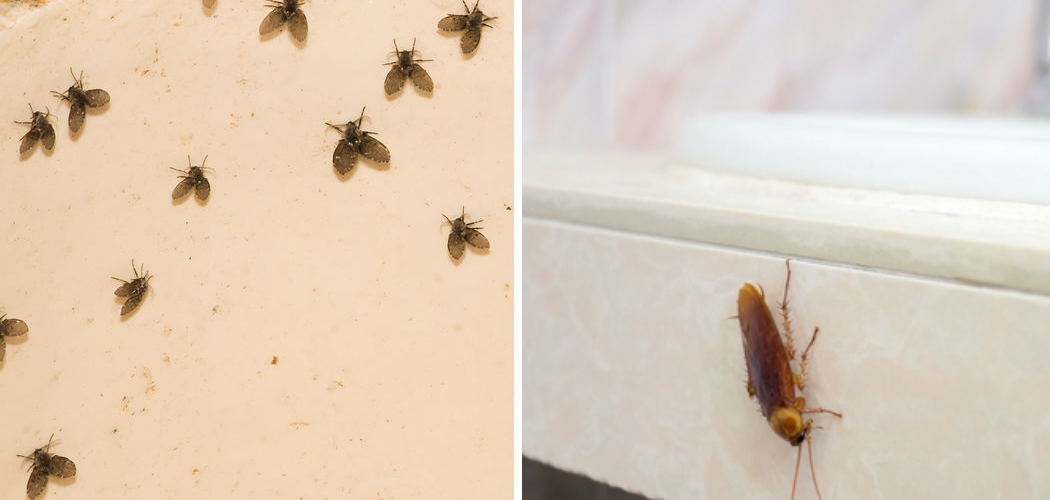Are you tired of constantly finding insects in your bathroom? It’s not only unsightly, but it can also be unhygienic and make you uncomfortable in your home. Don’t worry; there are steps you can take to effectively get rid of these pesky creatures and prevent them from coming back.
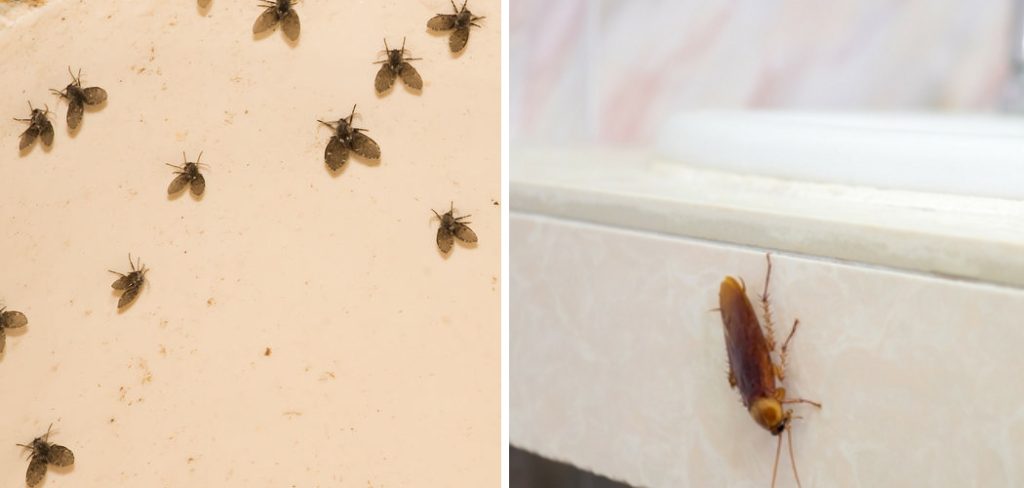
Discovering insects in your bathroom is unpleasant and can raise concerns about hygiene and health. Bathrooms, with their moist and often warm environment, can attract a variety of insects, such as ants, silverfish, and even cockroaches. Fortunately, there are effective strategies to rid your bathroom of these unwelcome guests.
This guide will provide practical steps on how to get rid of insects in bathroom, ensuring your bathroom remains a clean and comfortable space for your daily routines.
What are the Benefits of Keeping your Bathroom Insect-Free?
Before we dive into the methods of getting rid of insects in your bathroom, let’s first understand why it is important to keep them out.
- Hygiene: Bathrooms are essential to our daily routines, and keeping them clean and free from insects is crucial for maintaining good hygiene.
- Health: Insects can carry diseases and allergens that can harm our health, so keeping them out of your bathroom is essential for your well-being.
- Peace of Mind: An insect-free bathroom can provide a sense of peace and comfort, making it a more enjoyable space for you and your family.
- Prevent Further Infestations: By getting rid of insects in your bathroom, you can prevent them from spreading to other areas of your home.
Now that we understand why it’s important to keep insects out of our bathrooms let’s examine some effective methods for getting rid of them.
What Will You Need?
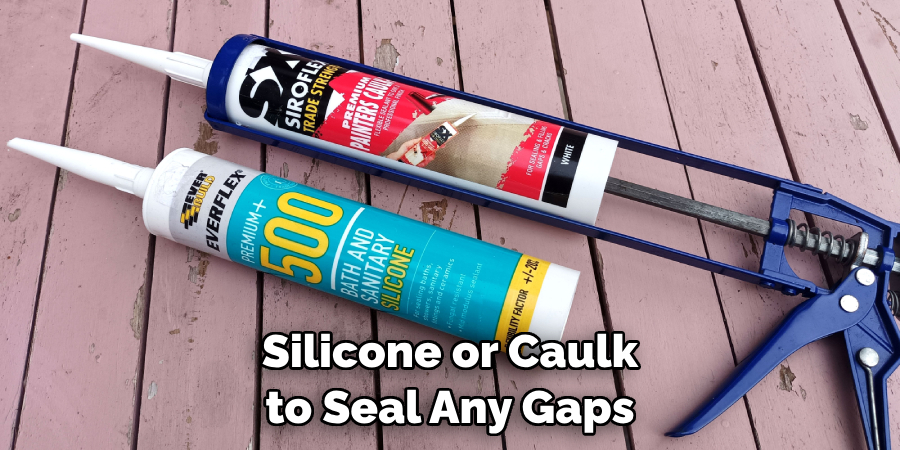
- Cleaning Supplies: This will include a disinfectant, an all-purpose cleaner, and a scrub brush.
- Sealants: Silicone or caulk to seal any gaps or cracks where insects may enter.
- Traps or Baits: These can be purchased at your local hardware store or made at home using household ingredients.
- Essential Oils: Certain essential oils, such as peppermint or lemon, can repel insects and leave your bathroom smelling fresh.
Once you have all the necessary supplies, you can begin implementing these steps to eliminate insects in your bathroom.
10 Easy Steps on How to Get Rid of Insects in Bathroom
Step 1. Identify the Source:
The first and most crucial step in eradicating insects from your bathroom is identifying their origin. Common entry points include windows, cracks in walls or flooring, and drainage systems.
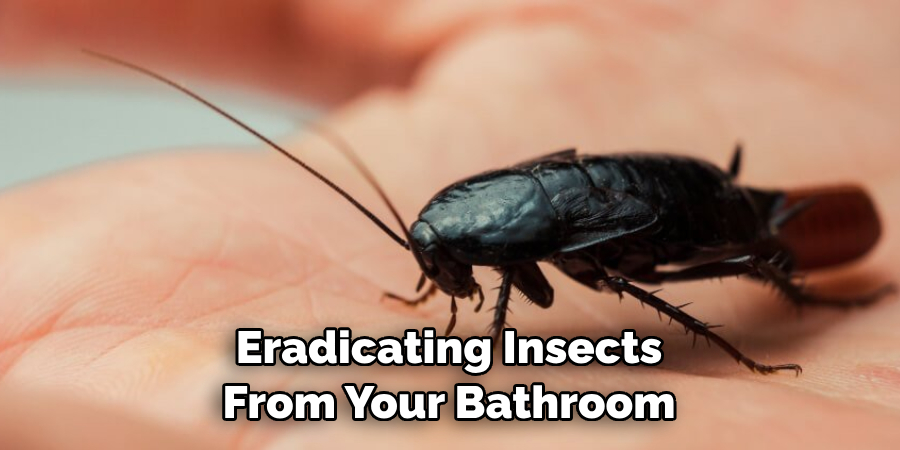
Pay close attention to damp areas, as many insects attract moisture. Once the source is identified, you can take targeted measures to eliminate their entry points and make your bathroom less inviting to these unwanted guests.
Step 2. Deep Clean the Bathroom:
A sparkling clean bathroom is far less attractive to insects than a neglected one. Begin by decluttering countertops and any other surfaces to eliminate hiding spots for insects. Proceed by scrubbing the floors, walls, and shower area with a disinfectant to remove any dirt, grime, or organic material on which insects might feed. Pay extra attention to the corners and hidden areas where insects like to hide.
Cleaning should also extend to drains; pour a mixture of baking soda and vinegar down the drains to clear away any organic matter that could attract insects. Lastly, make sure to regularly empty trash bins and keep them clean to discourage insects from gathering.
Step 3. Seal Gaps and Cracks:
After thoroughly cleaning your bathroom and identifying potential entry points for insects, the next important step is to seal any gaps or cracks. Use a high-quality silicone sealant or caulk to block these openings effectively. Pay particular attention to areas around pipes, windows, and doors, as these are common places for insects to enter.
Ensuring these gaps are sealed not only helps prevent insects from entering but also contributes to your home’s overall insulation and energy efficiency. Remember, even the smallest crack can be an invitation to pests, so it’s crucial to be meticulous during this process.
Step 4. Use Traps or Baits:
Setting up traps or baits can work wonders in controlling the insect population in your bathroom. Depending on the type of insects you’re dealing with, various options are available, from sticky traps for flies to bait traps for ants and cockroaches.
Place these traps near suspected entry points or in corners where insects are likely to travel. Be sure to check and replace these traps regularly to maintain their effectiveness. This method acts as both a means to eliminate existing pests and a way to monitor for new intrusions, helping you stay one step ahead in keeping your bathroom insect-free.
Step 5. Utilize Essential Oils:
Many insects are naturally repelled by the scent of certain essential oils, making them an effective, non-toxic way to keep your bathroom bug-free. Essential oils such as peppermint, lavender, tea tree, and eucalyptus can be used to create a repellent spray.

Simply mix a few drops of your chosen essential oil with water in a spray bottle and apply the mixture to areas where insects are likely to enter or congregate. Additionally, you can place cotton balls soaked in these oils in your bathroom’s drawers, cabinets, and corners. This not only helps deter insects but also leaves your bathroom smelling fresh and clean.
Step 6. Maintain Dry Conditions:
One of the most effective strategies to deter insects from your bathroom is to keep it as dry as possible. Insects, like many other pests, are drawn to moisture as it provides them with the necessary environment for survival and reproduction. Make it a habit to wipe down the shower walls and floor after each use.
Utilize a squeegee for this task to ensure efficient removal of water. Additionally, ensure that you fix any leaking taps or pipes promptly and consider using a dehumidifier to reduce the overall moisture level in your bathroom. Keeping towels, rugs, and any other fabrics dry will further discourage insect habitation, making your bathroom an unwelcome place for these unwelcome guests.
Step 7. Clean Drains Regularly:
Insects often enter bathrooms through drains that lead directly outdoors or to other parts of your plumbing system. Regularly cleaning these drains is essential in preventing insects from making their way into your bathroom.
Pouring boiling water down the drain once a week can help kill any insects or eggs that may be present. Additionally, a mixture of vinegar and baking soda can be used as a natural cleaning solution to break down organic matter that insects feed on. Ensuring your drains are clear not only prevents insect infestations but also helps maintain your plumbing system’s overall health.
Step 8. Install Screens on Windows and Vents:
An effective way to prevent insects from entering your bathroom is to install screens on windows and vents. These screens act as a physical barrier, allowing fresh air to circulate while keeping out flies, mosquitoes, and other pests.
Ensure that the screens are properly fitted and in good condition, with no tears or gaps where insects can squeeze through. Regularly inspect and clean these screens to maintain their effectiveness. This measure not only aids in keeping your bathroom insect-free but also enhances your home’s overall pest control strategy.
Step 9. Incorporate Natural Predators:
Incorporating natural predators into your bathroom environment can be a unique and eco-friendly way to combat insect infestations. For instance, introducing small houseplants that attract spider mites can help control the population of unwanted insects. Despite their often negative reputation, spiders can play a beneficial role by preying on common bathroom pests such as flies and mosquitoes.

It’s important to choose plants and predators that are harmless to humans and suitable for indoor environments. This approach not only helps reduce the insect population naturally but also adds a touch of greenery to your bathroom, enhancing its overall ambiance.
Step 10. Conduct Regular Inspections:
Regular bathroom inspections play a crucial role in early detection and prevention of insect infestations. Make it a part of your routine to examine areas around the sink, bathtub, toilet, and windows for signs of pests. Look out for droppings, wings, or other evidence that insects may be present.
Additionally, checking for dampness, leaks, or cracks in the walls and flooring can help identify potential entry points or breeding grounds for insects. By staying vigilant and conducting these inspections, you can address issues promptly, maintaining a clean and pest-free bathroom environment.
By following these steps and implementing the above strategies, you can effectively keep insects at bay in your bathroom.
5 Additional Tips and Tricks
- Ensure Proper Ventilation: Insects in the bathroom are often attracted to humidity and moisture. Installing an exhaust fan or regularly opening a window (if applicable) can reduce the humidity levels, making the environment less appealing for bugs.
- Fix Leaks Promptly: Water from leaks serves as a perfect drinking source for many insects. Inspect your bathroom regularly for leaks around the sink, bathtub, and toilet. Repairing these promptly can help deter insects.
- Regular Cleaning: Regularly clean your bathroom surfaces, floors, and drains. Soap scum, hair, and other debris can attract insects. Also, consider pouring boiling water down the drains weekly to kill any insect eggs that might be breeding.
- Seal Cracks and Crevices: Inspect your bathroom for any cracks or crevices in the walls, floors, or around the window frames. Use silicone-based caulk to seal these areas, preventing insects from entering the bathroom.
- Keep Plants and Trash Bins Away: Avoid placing plants or trash bins near your bathroom, as they can attract insects looking for food sources. If you do have plants in the bathroom, make sure to regularly check for any standing water in their trays, which could serve as a breeding ground for mosquitoes and other insects.
By following these additional tips and tricks, you can further prevent and eliminate insects in your bathroom.
6 Things You Should Avoid
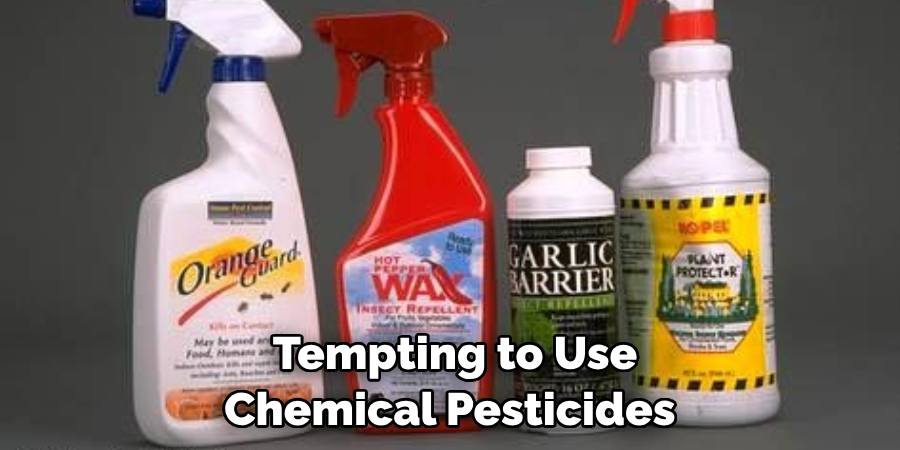
- Avoid Overuse of Pesticides: While it might be tempting to use chemical pesticides to quickly resolve insect issues, excessive use can pose health risks, especially in confined spaces like bathrooms. Opt for natural repellents and preventative measures first.
- Don’t Ignore Humidity Levels: High humidity is a major attractant for many types of insects. Using dehumidifiers or exhaust fans and not addressing humidity can allow insect populations to thrive.
- Don’t Leave Wet Towels and Rugs: Wet fabrics are inviting for insects, providing them with moisture and potential breeding grounds. Ensure towels and rugs are dried thoroughly after use or kept in well-ventilated areas.
- Avoid Stagnant Water: Do not leave standing water in sinks, bathtubs, or shower trays, as it can become a prime breeding site for mosquitoes and other insects. Regularly check and empty any containers that may collect water.
- Don’t Delay Repairs: Leaky faucets, pipes, and fixtures are not only a waste of water but also an open invitation for pests. Procrastinating repairs can turn minor issues into major infestations.
- Don’t Keep Old Unused Products: Expired or unused products stored in the bathroom, such as makeup, toiletries, and cleaning supplies, can attract insects. Discard any old or unused items regularly to prevent insect infestations.
Steering clear of these common mistakes can contribute significantly to maintaining an insect-free bathroom environment.
What are the Harmful Effects of Insects in the Bathroom?
There are several potential harmful effects of insects in the bathroom, including:
- Disease Transmission: Insects can carry and transmit diseases such as E. coli, salmonella, and gastroenteritis. These diseases can be particularly dangerous for children and individuals with weakened immune systems.
- Allergic Reactions: Insects like cockroaches, ants, and bees can trigger allergic reactions in some people, including skin irritation, respiratory issues, and even anaphylaxis.
- Sanitation Issues: Insects can contaminate surfaces and food in the bathroom, leading to poor sanitation and potential health hazards.
- Damage to Property: Some insects like termites or silverfish can cause damage to property by feeding on wood, paper, and fabric. This can result in costly repairs and replacements.
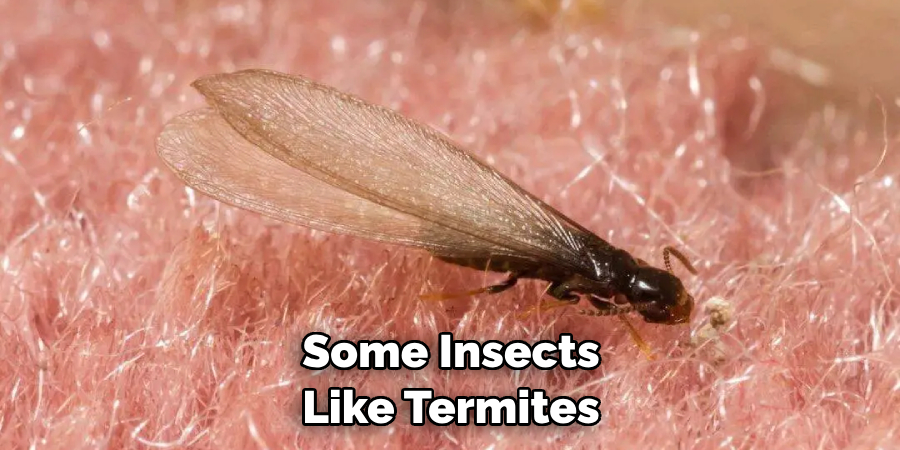
To prevent these harmful effects, it is essential to regularly monitor and promptly address any insect issues in the bathroom. Overall, maintaining a clean and well-ventilated bathroom is key to preventing insects and creating a safe and healthy environment for you and your family.
What Chemicals Can Be Used to Eliminate Insects in the Bathroom?
There are several chemical options that can be used to eliminate insects in the bathroom, including:
- Insecticides: These are chemical sprays or powders that kill insects on contact. They can effectively eliminate visible bugs but may not reach hidden or inaccessible areas.
- Foggers: These devices release a mist of insecticide into the air, reaching hidden areas and killing insects on contact. However, foggers can be hazardous to use in small, confined spaces like bathrooms.
- Baits: These are traps or baits containing poison that attract insects, ultimately leading to their death. Baits can effectively target specific types of insects, but they may take longer to work.
It is important to use these chemicals carefully and according to the instructions on the label. It is also recommended to opt for natural or organic options first before resorting to chemical solutions.
What Attracts Insects to Bathrooms in the First Place?
There are several factors that can attract insects to bathrooms, including:
- Humidity and Moisture: Many types of bugs thrive in humid environments and are often drawn to moisture sources like leaky pipes or standing water.
- Food Sources: Insects such as ants and cockroaches are attracted to food sources, including crumbs, spills, and even soap scum on shower walls.
- Clutter and Hiding Places: Cluttered areas in bathrooms provide hiding places for insects to nest and breed. These include piles of laundry, boxes or bags left on the floor, and stacks of paper or magazines.
- Warmth: Bathrooms can often be warmer than other areas of the house, making them an inviting environment for insects to thrive.
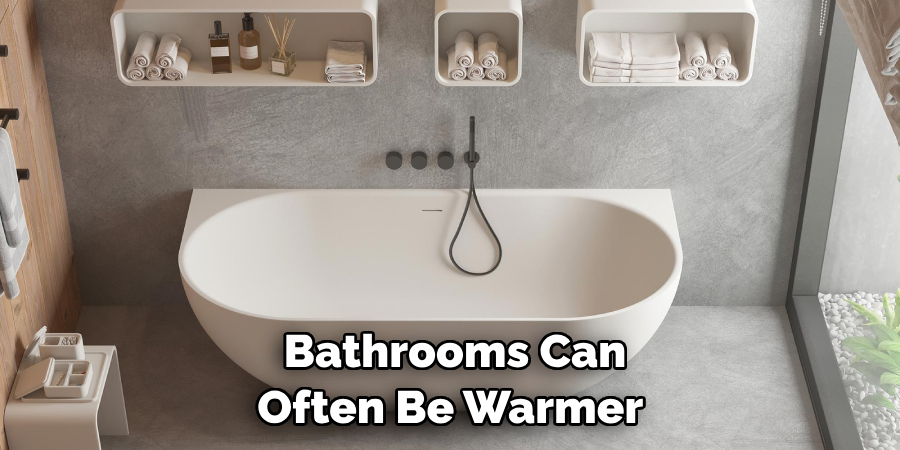
By addressing these attractants and implementing preventative measures, you can effectively reduce insect populations in your bathroom. Maintaining a clean and dry bathroom is key to preventing infestations and creating a less appealing environment for insects.
Conclusion
In conclusion, managing and eliminating insects in the bathroom requires a multi-faceted approach that emphasizes both prevention and active elimination. Key strategies include maintaining proper humidity levels, avoiding standing water, keeping areas dry and well-ventilated, promptly repairing leaks, and ensuring cleanliness and minimal clutter.
While natural methods are recommended for initial efforts, chemical interventions can be considered for persistent issues, with safety precautions firmly in place.
Awareness of what attracts insects to bathrooms and addressing these elements can significantly reduce their presence, creating a healthier and more comfortable environment. By implementing these strategies, homeowners can effectively minimize insect infestations in their bathrooms, safeguarding the health and well-being of their families.
Hopefully, this guide has provided valuable insights and tips on how to get rid of insects in bathroom. Remember to stay vigilant, address any issues promptly, and make a habit of keeping your bathroom clean and dry to prevent pesky bugs from taking over. Happy cleaning!

